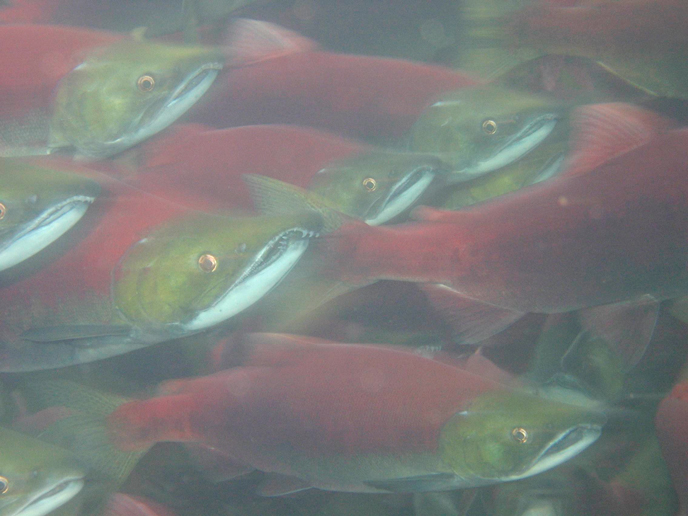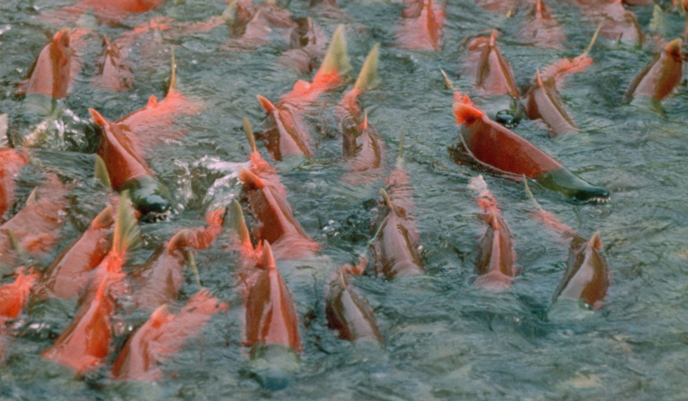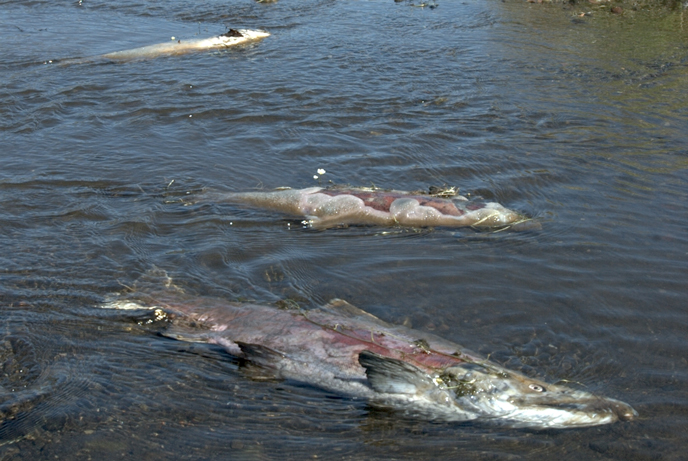
NPS Photo
Every summer between twenty-five and forty million sockeye salmon return to the lakes, rivers, and streams of the Bristol Bay watershed. The scale and density of Bristol Bay's salmon run, along with the obvious importance it holds for the region's economic and ecological health, lead us to think about sockeye collectively. This mentality is reinforced by salmon's lack of personality and charisma: since they all look and act alike, it becomes hard to perceive sockeye salmon as individuals. While it is very easy to see the whole, the individual parts are harder to distinguish. Salmon as a group are recognizably important; as individuals, their significance seems irrelevant.
Late summer and fall visits to Katmai's smaller streams and rivers offer more personal glimpses into the salmon's world and challenge such views. By this time the fish have reached their spawning streams, some of which are so small the salmons' backs stick out of the water. The great hordes of fish have splintered into smaller groups as well; some spawning groups may number a dozen or less. These are the few fish who have managed to avoid nets, dodge bears, jump waterfalls, and overcome other obstacles on the long journey home. Against immeasurable odds, they have reached the apex of a salmon's life: the spawning period. It is on these spawning grounds where the individual stories of salmon become more apparent.

The density of salmon can be extremely high in Katmai's small streams. NPS Photo
On a recent survey in Katmai National Preserve, I had an opportunity to watch one of these stories unfold. One morning a female sockeye, distinguished by a white growth on her head, was using her tail to excavate a nest in a stream bottom. Nearby was a large male sockeye, with a unique color pattern around his tail and dorsal fin. When other salmon approached the nest area, this male would rapidly swim toward the intruder, biting at tails and fins until the invader retreated. From time to time he would move over the nest site and fertilize the female's eggs.
For several hours I was able to keep track of these large, healthy salmon at the climax of their lives. But as morning transitioned to afternoon, the situation changed. While the female continued to work on her nest as before, the male began drifting away. He started moving more slowly, away from the female he had so vigorously defended. As he lethargically swam upstream other salmon began to bite as his fins, driving him further away and towards a side channel. Each time he reached the entrance to this channel he turned around, only to find himself driven back to it minutes later. With each turn, he moved a little slower. Spawning had completed his life, and now it was ebbing away.
A couple hours later, a dead salmon lay in the spot where I had last seen the male sockeye. A fine layer of silt covered it, turning the fish's bright red sides a dull brown. It lay there undisturbed for a while longer, until a bear wandered past. The bear picked the dead fish up, took a few bites, and dropped the remains back in the river; with that act, the powerful fish of the morning was now a half-eaten lunch. Downstream, the female continued digging and defending her nest, but now another male was by her side. For these two salmon, life would continue- if only for a few more hours.

For Pacific salmon, the journey to their spawning grounds is one way. They will not return to the sea. NPS Photo
People sometimes describe the sight of spawned-out salmon as sad, but perhaps poignant is a more accurate term. Humans perceive a tragic element in the life cycle of Pacific salmon, and watching a healthy animal rapidly weaken and die can be a touching experience. But the salmon's perspective is different. The sacrificial journey, which ends with death even if successful, is rewarded in mid-winter when the next generation of sockeye salmon rise out of the gravel.
